
Asteroids is a space-themed multidirectional shooter arcade video game designed by Lyle Rains and Ed Logg released in November 1979 by Atari, Inc. The player controls a single spaceship in an asteroid field which is periodically traversed by flying saucers. The object of the game is to shoot and destroy the asteroids and saucers, while not colliding with either, or being hit by the saucers' counter-fire. The game becomes harder as the number of asteroids increases.

Pac-Man, originally called Puck Man in Japan, is a 1980 maze action video game developed and released by Namco for arcades. In North America, the game was released by Midway Manufacturing as part of its licensing agreement with Namco America. The player controls Pac-Man, who must eat all the dots inside an enclosed maze while avoiding four colored ghosts. Eating large flashing dots called "Power Pellets" causes the ghosts to temporarily turn blue, allowing Pac-Man to eat them for bonus points.
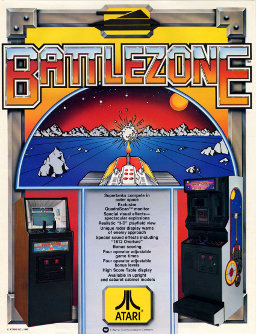
Battlezone is a first-person shooter tank combat game released for arcades in November 1980 by Atari, Inc. The player controls a tank which is attacked by other tanks and missiles. Using a small radar scanner along with the terrain window, the player can locate enemies and obstacles around them in the barren landscape. Its innovative use of 3D graphics made it a huge hit, with approximately 15,000 cabinets sold.

Alias Smith and Jones is an American Western television series that originally aired on ABC from January 1971 to January 1973. The show initially starred Pete Duel as Hannibal Heyes and Ben Murphy as Jedediah "Kid" Curry, outlaw cousins who are trying to reform. The governor offers them a clemency deal on two conditions: that they keep the agreement a secret, and that they will remain wanted fugitives until the governor decides that they should receive a formal amnesty.

Breakout is an arcade video game developed and published by Atari, Inc. and released on May 13, 1976. It was designed by Steve Wozniak, based on conceptualization from Nolan Bushnell and Steve Bristow, who were influenced by the seminal 1972 Atari arcade game Pong. In Breakout, a layer of bricks lines the top third of the screen and the goal is to destroy them all by repeatedly bouncing a ball off a paddle into them. The arcade game was released in Japan by Namco. Breakout was a worldwide commercial success, among the top five highest-grossing arcade video games of 1976 in both the United States and Japan and then among the top three highest-grossing arcade video games of 1977 in the US and Japan. The 1978 Atari VCS port uses color graphics instead of a monochrome screen with colored overlay.

Gunfighters, also called gunslingers, or in the late 19th and early 20th century, gunmen were individuals in the American Old West who gained a reputation of being dangerous with a gun and participated in shootouts. Today, the term "gunslinger" is more or less used to denote someone who is quick on the draw with a handgun, but this can also refer to those armed with rifles and shotguns. The gunfighter is also one of the most popular characters in the Western genre and has appeared in associated films, television shows, video games, and literature.

Gun Fight, known as Western Gun in Japan and Europe, is a 1975 multidirectional shooter arcade video game designed by Tomohiro Nishikado, and released by Taito in Japan and Europe and by Midway in North America. Based around two Old West cowboys armed with revolvers and squaring off in a duel, it was the first video game to depict human-to-human combat. The Midway version was also the first video game to use a microprocessor instead of TTL. The game's concept was adapted from Sega's 1969 arcade electro-mechanical game Gun Fight.
The following article is a broad timeline of arcade video games.

Air-Sea Battle is a fixed shooter developed and published by Atari, Inc. for the Atari VCS. Air-Sea Battle is partially based on the 1975 Atari arcade video game Anti-Aircraft where each player uses a ground-based gun to shoot passing aircraft. The cartridge adds other variants, such as planes dropping bombs on ships and a carnival-themed shooting gallery.
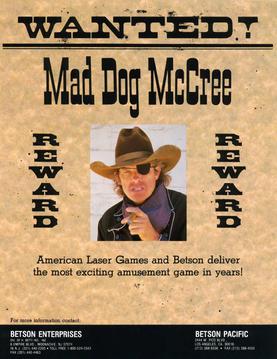
Mad Dog McCree is the first live-action laserdisc video game released by American Laser Games. It originally appeared as an arcade game in 1990.
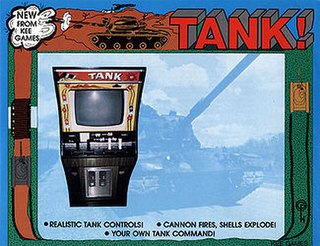
Tank is an arcade game developed by Kee Games, a subsidiary of Atari, and released in November 1974. It was one of the few original titles not based on an existing Atari property developed by Kee Games, which was founded to sell clones of Atari games to distributors as a fake competitor prior to the merger of the two companies. In the game, two players drive tanks through a maze viewed from above while attempting to shoot each other and avoid mines, represented by X marks, in a central minefield. Each player controls their tank with a pair of joysticks, moving them forwards and back to drive, reverse, and steer, and firing shells with a button to attempt to destroy the other tank. The destruction of a tank from a mine or shell earns the opposing player a point, and tanks reappear after being destroyed. The winner is the player with more points when time runs out, with each game typically one or two minutes long.

Call of Juarez is a first-person shooter set in a Western milieu developed by Techland. Published in Europe for Microsoft Windows by Focus Home Interactive in September 2006, in Australia by Auran Development in October 2006, and in North America by Ubisoft in June 2007, it was ported to the Xbox 360 by Techland in June 2007, published worldwide by Ubisoft. The game was also released on Steam. In March 2011, it was made available on Xbox Live, and in November 2018, it was released on GOG.com. It is the first game in the Call of Juarez series, which would go on to include three additional titles; Call of Juarez: Bound in Blood, Call of Juarez: The Cartel, and Call of Juarez: Gunslinger.
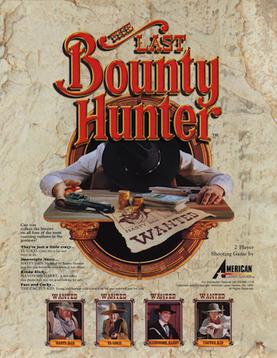
The Last Bounty Hunter is a live-action laserdisc video game released by American Laser Games in 1994. Like almost all of the games produced by the now-defunct company, it is a rail shooter and, like the two installments in the Mad Dog McCree series before it, is set in the Old West. However, it takes a more comedic approach than the Mad Dog McCree games in both its story sequences and the characters' comically exaggerated reactions to being shot. Filmed at Old Tucson Studios in Tucson, Arizona, it was one of the company's last releases before it was forced to close down. It was re-released by Digital Leisure in 2002 and was eventually packaged with Fast Draw Showdown by Global VR as an arcade cabinet under the name Six Gun Select.

Sea Wolf is an arcade video game designed by Dave Nutting and released by Midway in 1976. It is a video game update of an electro-mechanical Midway game, Sea Devil, itself based on Sega's 1966 electro-mechanical arcade submarine simulator Periscope. The game was released in Japan by Taito. In Sea Wolf, the player, piloting an unseen submarine, launches torpedoes vertically in an attempt to sink ships moving horizontally across the screen before time runs out. The screen is viewed through a faux periscope mounted on the cabinet.

Hi-way, also known as Highway, is a 1975 single-player arcade racing game by Atari Inc. Marketed with the slogan "Hi Way — All It Needs Is Wheels", it was Atari's first game to use a sit-down arcade cabinet.
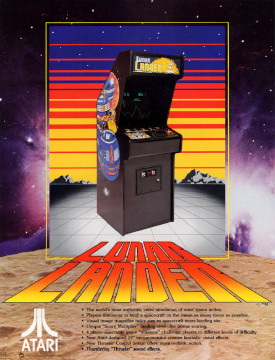
Lunar Lander is a single-player arcade game in the Lunar Lander subgenre. It was developed by Atari, Inc. and released in August 1979. It was the most popular version to date of the "Lunar Lander" concept, surpassing the prior Moonlander (1973) and numerous text-based games, and most later iterations of the concept are based on this Atari version.

Call of Juarez: Bound in Blood is a first-person shooter set in a Western milieu for Microsoft Windows, PlayStation 3, and Xbox 360. Developed by Techland and published by Ubisoft, it was released in North America in June 2009 and in Australia and Europe in July. The game was also released on Steam. In December 2011, it was made available on the PlayStation Store and the Xbox Games Store, in November 2018, it was added to Microsoft's backward compatibility program, making it playable on the Xbox One and Xbox Series X/S, and in September 2019, it was released on GOG.com. It is the second game in the Call of Juarez series, although narratively, it is a prequel to the first game.
Call of Juarez is a first-person shooter video game series created by Paweł Selinger in 2006. Released primarily on Microsoft Windows, PlayStation 3, and Xbox 360, there are four games in the series; Call of Juarez (2006), Call of Juarez: Bound in Blood (2009), Call of Juarez: The Cartel (2011), and Call of Juarez: Gunslinger (2013). Techland has developed all four games, and as of 2018, owns the publishing rights. From 2006 to 2018, Ubisoft held the publishing rights.

Speed Race is a 1974 arcade racing video game developed and manufactured by Taito and released under the titles Racer and Wheels in North America by distributor Midway Manufacturing in 1975. Designed by Tomohiro Nishikado, the gameplay involves the player using the attached steering wheel to maneuver a car alongside a fast vertical scrolling road. The objective is to score points by driving past other cars without colliding with them; more points are awarded for driving faster. Players must do this under a 90-second time limit, which ends the game when it runs out. The gameplay concepts were adapted from two earlier driving electro-mechanical games: Kasco's Mini Drive (1958) and Taito's Super Road 7 (1970).

















